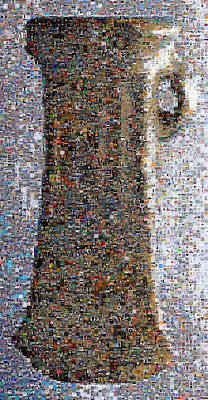02 - 03 November 2006
Digital Photomosaic (80x158cm)
Detail below.
Digital Photomosaic (80x158cm)
Detail below.
Sometime in the late third millennia BC in England, people began to alloy tin with copper to create bronze. By alloying these elements (c. 10-12% tin and 88-90% copper), smiths were able to lower the melting point of copper, reduce oxygen absorption, increase the metal flow, improve castings and produce more complex shapes. This image depicts a bronze socketed axehead, discovered at the site ofWhitchurch, a Late Bronze Age midden and occupation complex in Warwickshire, England. Middens are complex sites which develop at the Late Bronze Age/Early Iron Age transition. This piece was deposited in a focal place where groups of people periodically gathered together, away from the daily routine that is often associated with permanent settlements.
The site is currently under the directorship of Kate Waddington and Niall Sharples from Cardiff University. The preliminary excavation at Whitchurch in September 2006 produced the largest assemblage of finds for prehistoric Warwickshire. This demonstrates the tremendous importance of the site for the area and for Britain as a whole in this period.

The image is composed of a collage of 4315 ‘cell-images’ resulting from unfiltered searches for the words ‘tin’, ‘copper’ and ‘bronze’, through the Google ‘Image Search Engine’. These words were chosen as they constitute the materials and alloy of the socketed axehead.
Some scholars have argued that archaeologists tend to focus more on the materiality of objects and material culture, than the materials themselves. The concerns are that current archaeologists engage more with abstract ruminations of theorists and philosophers than with the tangible elements with which craftspeople and manufacturers create. This ‘return to the materials’ approach runs the risk of encouraging essentialist understandings of the nature of physical materials. The viewer is therefore invited to explore the cell-images in this mosaic and the multiple visual associations relating to the etymologies of such ‘basic’ materials and essences.
The site is currently under the directorship of Kate Waddington and Niall Sharples from Cardiff University. The preliminary excavation at Whitchurch in September 2006 produced the largest assemblage of finds for prehistoric Warwickshire. This demonstrates the tremendous importance of the site for the area and for Britain as a whole in this period.

The image is composed of a collage of 4315 ‘cell-images’ resulting from unfiltered searches for the words ‘tin’, ‘copper’ and ‘bronze’, through the Google ‘Image Search Engine’. These words were chosen as they constitute the materials and alloy of the socketed axehead.
Some scholars have argued that archaeologists tend to focus more on the materiality of objects and material culture, than the materials themselves. The concerns are that current archaeologists engage more with abstract ruminations of theorists and philosophers than with the tangible elements with which craftspeople and manufacturers create. This ‘return to the materials’ approach runs the risk of encouraging essentialist understandings of the nature of physical materials. The viewer is therefore invited to explore the cell-images in this mosaic and the multiple visual associations relating to the etymologies of such ‘basic’ materials and essences.

No comments:
Post a Comment